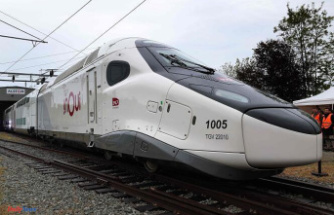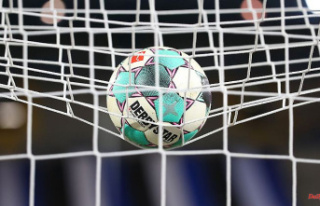Why discuss the extraordinary Ferrari legend F40 together with a Scuderia 16M? Because a Ferrari enthusiast has them in his collection. Also, they're about 20 years apart, which makes for an interesting comparison. Both can experience ntv.de at the wheel.
The Ferrari phenomenon is definitely not a West German one, as much would be proven after a visit by a self-made man from Thuringia. The brand lover has collected a few beautiful pieces from Maranello and is far from finished.
In any case, the garages offered here today, in addition to the longing Ferrari par excellence - of course, the F40 is meant - also a Scuderia 16M Spider. And for various reasons, that is actually a good thing, which at first glance may well remain hidden. Both are eight cylinders. Both are collector cars. Both want to offer maximum driving pleasure. It is true that the F40 is much more valuable today than the sporty top model of an entry-level series. But fun fact: the Scuderia Spider is the much rarer car with 499 examples. In the end, 1315 examples of the F40 were built - Ferrari was persuaded to produce many more units than originally planned due to the high demand.
Anyone discussing the F40 has to look back to 1984. At that time, the GTO ("Gran Turismo Omologato" - the 288 is not an official designation) appeared as a homologation vehicle for the Group B rally commitment. A concept was born that Ferrari hadn't had before: the engineers equipped the 2.9 eight-cylinder with two Japanese IHI exhaust gas turbochargers. The engine brought it to 400 hp (more than ever before with Ferrari) and accelerated the 1284-kilogram athlete brutely - at that time, Porsche planned a maximum of 300 hp.
Seen in this way, the F40 is a logical further development of the GTO, but now much more radical. While its predecessor was designed more as a fast street athlete, the F40 wanted to be a street-legal racer. In addition to the consistent lightweight construction (as with the predecessor with a plastic and carbon fiber body), the focus is now also on aerodynamics, which primarily focuses on downforce. The many body gimmicks such as air guide levels and intakes exist to achieve the perfect balance between downforce and cw optimum. The Italian does not drive the big spoiler for fun. A lack of any comfort also characterizes its character.
Like the GTO, the F40, which is also equipped with the two IHI chargers, weighs a similar amount or little - namely 1254 kilograms. He has a spartan interior, not even the power windows are electric. The only thing Ferrari didn't do without was the air conditioning. Better so with the sweaty eight-cylinder in the neck.
Okay, enough talking shop, give it a try! First climb over the sill and climb the F40, which incidentally belonged to racing legend Gerhard Berger in its first life. Then put on the four-point belt and reach for the unlabelled start button. The eighth snorts, has potential for addiction, no question. The clutch pedal is even tighter than expected, the overview is modest. But it doesn't matter, because very few road users are likely to overtake the F40. And even if they could, out of reverence they would not.
The owner has already heated the engine oil, so I can let the eight-cylinder breathe deeply. First, the rolling legend pushes moderately and powerfully, then smashes it into the right horizon when the boost pressure starts. Wait a minute, but the oldie has "only" 478 hp - so little compared to current super sports cars. Right, but what about the weight again? The Legends Ferrari is a flyweight and only has to tow 2.62 kilograms per horsepower. No wonder he's really evil.
Contemporary specialist magazines have determined around eleven seconds for the sprint from 0 to 200 km/h - today still more remarkable, at the end of the eighties unimaginable. I leave it at a straight country road and behave again after a few sprints, because an F40 has become too valuable to mess with.
My car date then offers me the wheel of the Scuderia Spider - this is the open, primed version of the wide-ranging F430 range. Broadly applied in this case means: There are many, many thousands of 430 copies. Stop, but not from the Scuderia, that was already an issue.
Exactly, with the racer, which has been strengthened from 490 to 510 hp, which incidentally does not bear the model designation "430" in its name, Ferrari celebrated its constructors' championship of the year 2008. The developers dug deep into their bag of tricks and revised the intake system of the willingly rotating V8. It deserves respect that the technicians managed to slim down the track version by 100 kilograms - the use of light materials such as carbon makes it possible. Even the air filter boxes and the box around the coolant filler neck are made of carbon fiber, which is used as decoration inside anyway.
Experts recognize the output for the course by the distinctive diffuser. It is not only visually fine, but also provides the necessary downforce on the track to get the last tenth of a second out. Incidentally, the Scuderia accelerates to 200 km/h just as quickly as the turbocharged oldie - another similarity.
The same applies to the Scuderia on the exit as to the F40: beautifully piano. Sit quickly in the sports chair, start the sonorous eight-cylinder at the push of a button and heat it up moderately. However, the surrounding lonely country roads give the opportunity to challenge the engine, which screeches throatily in the upper speed regions, at least a little. The tour meter allows ten thousand rotations, at least at 8500 the said 510 hp are available.
And since even the open 16M tips the scales at just over 1400 kilograms, you can imagine how dramatically it presses its passengers into their seats. Once properly loaded with the right pedal and the stomach rides a roller coaster in the true sense of the word. The feeling is different than in the F40. The naturally aspirated engine pushes linearly and the Manettino with the different modes, always visible in the corner of your eye, reminds you that the Scuderia has the lifeline in the form of a stability program, which has a great psychological effect. For the Scuderia, the technicians even developed a special set-up inspired by Formula 1 - in order to drive out such differences, you have to have track experience. Be that as it may, it is fun to drive one way or another.
But the Scuderia 16M can also cruise moderately, after all it has an openable top. And convertibles always invite you to occasionally explore the area in the fresh air. In fact, the chassis is naturally taut, but not shockingly hard. And the automated six-speed transmission, which reacts brutally fast on the race track, can be shifted in a relaxed manner without any interruptions in traction. In any case, if you have recognized Ferrari's shifting strategy and deal with the accelerator pedal accordingly.
The obligatory question of which candidate to choose, which is otherwise obligatory in such comparisons, does not arise here - of course you have to have both. Of course, the Scuderia does not reach the legendary status of the F40, but it should surpass the performance. Of course, he's 20 years younger. And cheaper. So please study the Ferrari offers in the relevant stock exchanges if you have the budget somehow!












